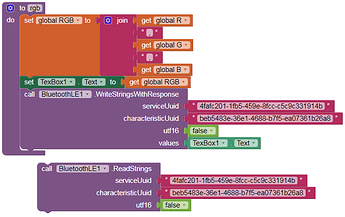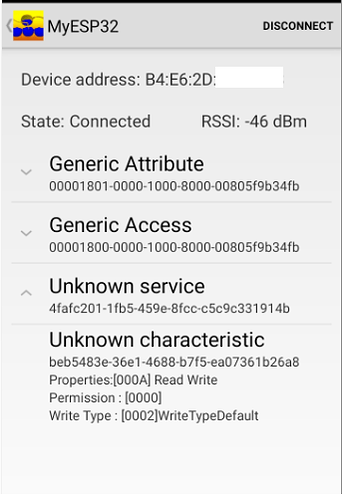8.- PushButton in ESP2 sends HIGH/LOW to App Inventor. Notify.
p110_esp32_ble_notifica_Pulsador.aia (185.0 KB)
-
PushButton in pin12 of ESP32 sends “HIGH” or “LOW” to App Inventor by BLE Notify.
-
It also turns ON/OFF LED2 of the ESP32 (it is a LED_BUILTIN)
/* Based on Neil Kolban example for IDF: https://github.com/nkolban/esp32-snippets/blob/master/cpp_utils/tests/BLE%20Tests/SampleNotify.cpp Ported to Arduino ESP32 by Evandro Copercini updated by chegewara Create a BLE server that, once we receive a connection, will send periodic notifications. A connect hander associated with the server starts a background task that performs notification every couple of seconds. */ // Modificado por Juan A. Villalpando // http://kio4.com/arduino/160i_Wemos_ESP32_BLE.htm #include <BLEDevice.h> #include <BLEServer.h> #include <BLEUtils.h> #include <BLE2902.h> #define pin12 12 // pin12 PushButton #define pin2 2 // pin2 LED2 int valor12; // Status PushButton String output ="LOW"; // Output to App. Notify. BLEServer* pServer = NULL; BLECharacteristic* pCharacteristic = NULL; bool deviceConnected = false; bool oldDeviceConnected = false; uint32_t value = 0; #define SERVICE_UUID "4fafc201-1fb5-459e-8fcc-c5c9c331914b" #define CHARACTERISTIC_UUID "beb5483e-36e1-4688-b7f5-ea07361b26a8" class MyServerCallbacks: public BLEServerCallbacks { void onConnect(BLEServer* pServer) { deviceConnected = true; }; void onDisconnect(BLEServer* pServer) { deviceConnected = false; } }; void setup() { pinMode(pin12, INPUT); // pin12 PushButton pinMode(pin2, OUTPUT); // pin2 LED2 Serial.begin(115200); // Create the BLE Device BLEDevice::init("MyESP32"); // Create the BLE Server pServer = BLEDevice::createServer(); pServer->setCallbacks(new MyServerCallbacks()); // Create the BLE Service BLEService *pService = pServer->createService(SERVICE_UUID); // Create a BLE Characteristic pCharacteristic = pService->createCharacteristic( CHARACTERISTIC_UUID, BLECharacteristic::PROPERTY_READ | BLECharacteristic::PROPERTY_WRITE | BLECharacteristic::PROPERTY_NOTIFY | BLECharacteristic::PROPERTY_INDICATE ); // Create a BLE Descriptor pCharacteristic->addDescriptor(new BLE2902()); // Start the service pService->start(); // Start advertising BLEAdvertising *pAdvertising = BLEDevice::getAdvertising(); pAdvertising->addServiceUUID(SERVICE_UUID); pAdvertising->setScanResponse(false); pAdvertising->setMinPreferred(0x0); // set value to 0x00 to not advertise this parameter BLEDevice::startAdvertising(); Serial.println("Waiting a client connection to notify..."); } void loop() { // notify changed value if (deviceConnected) { pCharacteristic->setValue(output.c_str()); // Output pCharacteristic->notify(); valor12 = digitalRead(pin12); // Read pin12 --> valor12. ( 0 or 1) if (valor12 == HIGH) { digitalWrite(pin2, HIGH); // if valor12 is HIGH, set pin2 HIGH Serial.println("Pulsado"); output ="HIGH"; // Notify HIGH } if (valor12 == LOW) { digitalWrite(pin2, LOW); // If valor12 is LOW, set pin2 LOW Serial.println("No Pulsado"); output ="LOW"; // Notify LOW } delay(100); // bluetooth stack will go into congestion, if too many packets are sent. } // disconnecting if (!deviceConnected && oldDeviceConnected) { delay(500); // give the bluetooth stack the chance to get things ready pServer->startAdvertising(); // restart advertising Serial.println("start advertising"); oldDeviceConnected = deviceConnected; } // connecting if (deviceConnected && !oldDeviceConnected) { // do stuff here on connecting oldDeviceConnected = deviceConnected; } }

















